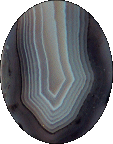| |
Agate
|
|
Agate is one of man’s earliest gemstones; some estimate that humans first began working this stone over 18,000 years ago during the neolithic. Because of its beauty, hardness, and availability the agate later became the stone of choice for cameos, signet rings, and other talismans. Theophrastus claimed the name agate was derived from the river Achate in Sicily, and reported that this river was the place where these stones were first found. Pliny repeats this story in Natural History, and goes on mention several varieties of agates:
|
| Iaspachates | “jasper agate” | - Jaspers |
| Cerachates | “wax agate” | - Blue Chalcedony |
| Smaragdachates | “emerald agate” | - green agates |
| Haemachates | “blood agate” | - Carnelian, Sard, or Red Sardonyx |
| Leucaehates | “milk agate” | - White or gray milky agates. |
| Dendrachates | “tree agate” | - Jaspers |
| Iaspachates | “jasper agate” | - Any dendritic agates including Tree and Moss Agate. Unlike modern lapidaries, Pliny did not require a stone to be translucent in order to be an agate.
|
|
|
This leads to another issue with examining old lapidaries and bits of folklore in general. Taxonomy, nomenclature, and understandings change with time and population. Two of the agates mentioned by Pliny could not have been agates as we know them today and one of them is not even a stone.
|
| Coralloachates |
Unknown |
Pliny called this stone the “sacred agate” of Crete, and describes this stone as the mottled like a sapphire with drops of gold. This is very clearly a description of lapis lazuli, which would have been coming through Cretan ports from the Near East for several centuries by Plinys time. |
| Stactachates |
“Myrrh Agate” |
Pliny describes this stone as smelling like myrrh when burned. This is not possible for any actual stone so he was describing a resin of some sort. I strongly suspect Pliny is describing amber. This crystalized resin visually resembles a stone and is thought of as one of the organic gems today. When burned it emits a sweet scent, and this would explain his later descriptions and burning agates for various purposes like quelling storms. It is from natural histories that the myth of the agate smelling sweet when heated or burned originated. This is pure speculation but the myth may have continued due to the habit of enhancing stones with oil, or making primitive paste gems. Because these stories take place well before the advent of petroleum distillates, these alterations would have had to have been done with natural resins. Many of these resins would have likely emitted a sweet odor when heated or burned. The irony is that, if this theory is correct, the sweet smell would not be a sign of a genuine stone as the folklore often claims, but evidence of adulteration.
|
|
Today we recognize many different types of cryptocrystalline quartz as agate, some like chalcedony and carnelian are now thought of as distinct stones and so have legends all their own. Much of the folklore relies on visual appearance and the doctrine of signatures to establish the virtue of the agate. This is the case when agates with concentric rings are cut into cabochons that resemble human eyes in order to ward off the evil eye. Or when milky white or gray agates are used to increase lactation and ease child birth. In these types of folklore the appearance of the stone is of more importance than the type of agate.
|
There are also several recorded instances of specific types of agates possessing specific virtues:
Albertus Magnus and Marbodus, Bishop of Rennes, both describe an unknown black agate with yellow veins that could be found on the island of Crete and would enable the wearer to become eloquent, preserve his health and strength, and protect him from dangers.
Albertus Magnus claimed the Indian agate will quench thirst and protect form poison.
Pilny said that the moss agate would ensure fertile crops and property if worn on the arm of a plowman, or tied to the horns of the ox pulling the plow.
|
There is a bit of classical folklore is applied to all agates, and the folklore between types of agates gets a bit muddled as it is repeated. For instance, the ability to cure the bites of spiders and scorpions is ascribed to agates from various regions. Carnado claimed that all types of agate would make the wearer “temperate, continent, and cautious; therefore, they are all useful for acquiring riches”. Marbodus claim that the Cretan agate, Coralloachates though described differently, would make the wearer more eloquent. This association with increase character presence is echoed in Lithica where it is said that the agate could make the wearer so persuasive, they could steal the hearts of women, and turn the minds of men. This text also bestowed on the agate the additional power to cure fevers and swelling, and may have been generalizing Albertus Magnus’ description of the Indian agate with the claim that it would combat thirst when held in the mouth.
The belief that agates could protect or cure spider and scorpion bites, increase eloquence, protect from danger, and counteract fever and heat are themes that get redistributed among various types of agates as the folklore is recounted in later lapidaries.
|
Colors
|
Agate can be found in almost every color.
|
Locations
|
Agate is found worldwide.
|
Compisition
|
SiO2, semipellucid crystallized quartz silicate
|
Hardness
|
6 - 7
|
|

|

|

|
|
|
|
|
|